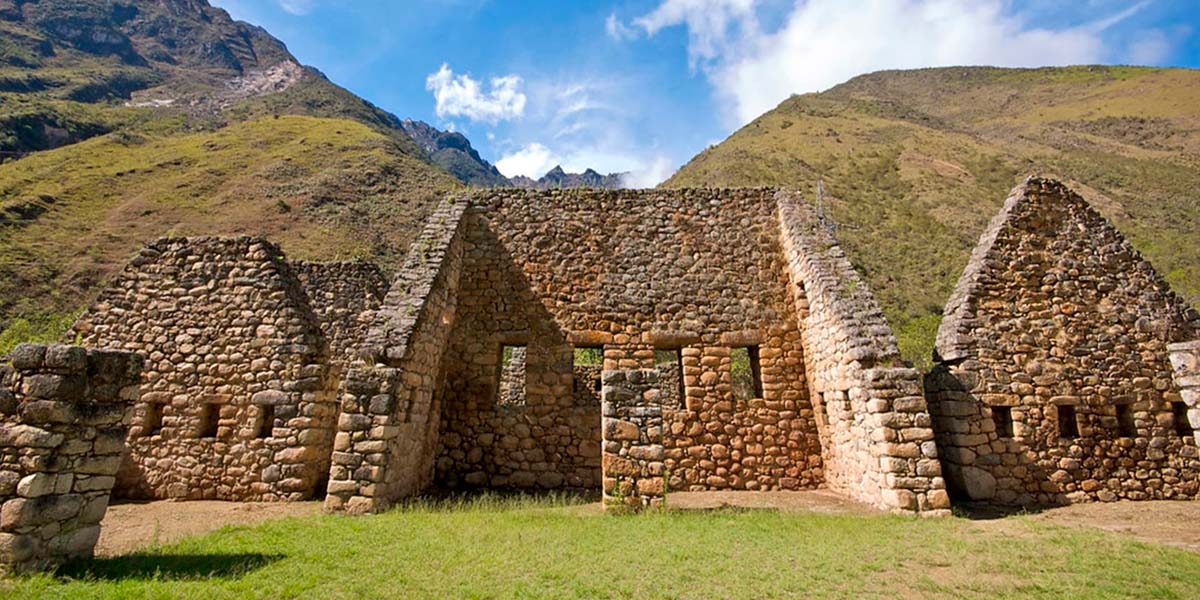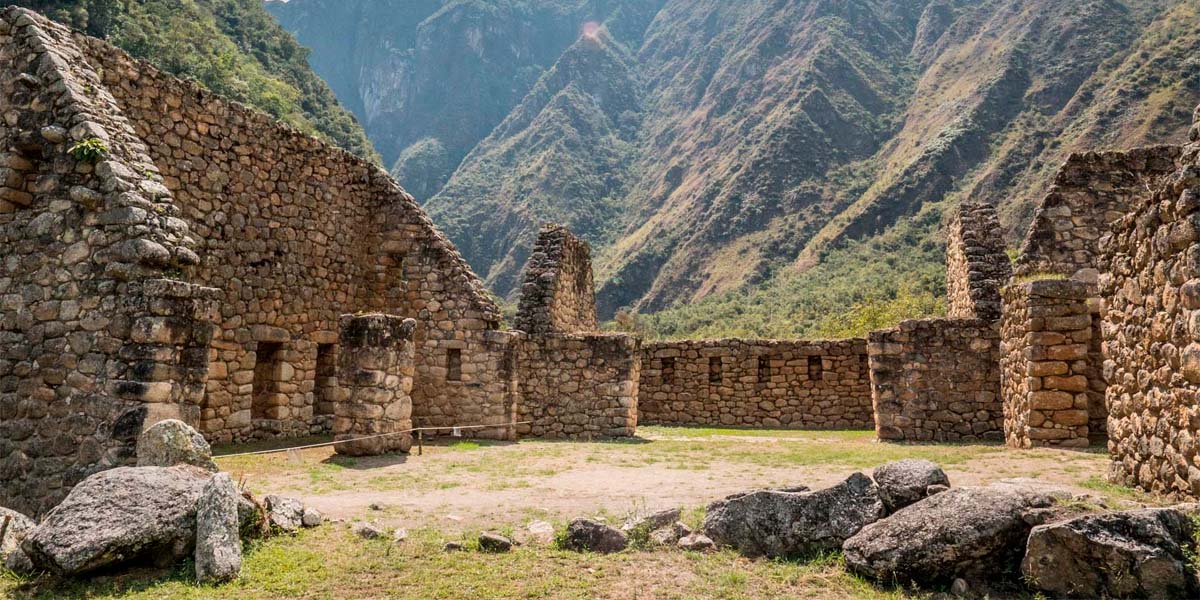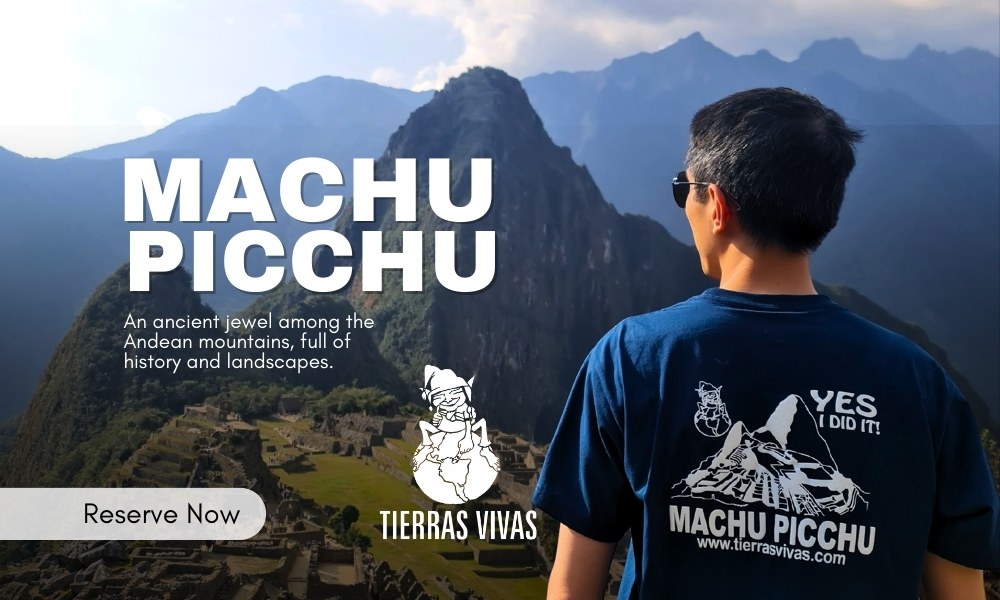The 2 day Inca Trail to Machu Picchu is the easiest version of this trek. There are several ways to get to the Inca citadel. Day 1 includes about 7 hours of walking, where you will see Chachabamba, a beautiful Inca ruin where we take a tour with a professional guide. Do you want to know more?
These ruins, discovered in 1940, are located on the old Inca road that ran along the southern bank of the Urubamba River. The style of buildings and stonework suggest that this used to be an important religious site, as well as having the secondary function as a gate house guarding this entrance to Machu Picchu.
Location
On our short Inca Trail itinerary, the impressive archaeological site of Chachabamba is located on the ancient route used in times of the empire, which partly follows the course of the Urubamba river. For its construction, the Incas had to open a clearing in the jungle. It is located 2,171 meters above sea level (6,995 feet above sea level), already descending in the subtropical Andean forest. It is a magnificent place!
The Chachabamba ruins in the Inca Trail is located in the middle of beautiful and huge green mountains, with an invaluable view, where the clouds are almost in front of the hikers.
The Origin of its historic name
The name of this archaeological site has slight variations from Quechua. The Chachabamba is said to come from 2 words “Chacha” which means welts and / or bites produced by the mosquitoes that live in the valley and “Bamba” which would have no other meaning than valley or place, which would have the final result “Valley mosquito bites".
Another of the theories about its possible translation and that perhaps you find the most beautiful to hear is: "Valley of the origin of the waters", which derives from the Quechua that gets its words from the onomatopoeic sounds of nature, in this case the syllables Cha ... cha ... "would come from the sound that water makes when falling through waterfalls" giving full meaning to its translation into Spanish.
History of Chachabamba in Perú
The ruins such as Chachabamba in Perú were discovered in 1940, being within the traditional Inca Trail route that followed the current along the coast of the Urubamba river to a subtropical height of 2,171 meters above sea level in the region known as Antisuyo. Due to the shape of its buildings and the architectural order that they are contemplating, it can be said that Chachabamba would also have been built for important religious purposes.
Purpose of Chachabamba ruins in Perú
"It is believed that an archaeological site was a place destined for the Water Treaty" or that "it served as a place of refuge before entering Machu Picchu."
Current archaeological and historical investigations maintain that this site was probably built for one of the following two reasons: first, as a military fort to control the entire area, because it was access to the vicinity of Machu Picchu, which was the luxury retreat for the emperor, his family, and the rest of the court. Second, as a religious complex to worship water, it was a central deity for them, due to the essential importance of agriculture for their survival.
This highlight, the Chachabamba site, according to archaeological studies, was first built as an important religious site for water worship; the Incas had a very strong connection with nature, which they called Pachamama (Mother Earth). Its economy was based on agriculture, reason why both the cult to the Pachamama and the deity of the water were very important in their vision of the world.
Second, the Chachabamba site was also a checkpoint for people heading to the Machu Picchu sanctuary; Machu Picchu was a place where all the Inca leaders went on "vacations", so to speak, it was a royal retreat, so they also took some security measures. The Inti Punku (Puerta del Sol), which is the entrance to Machu Picchu, is also a checkpoint guarded by elite soldiers.
Design of the Chachabamba Citadel in Perú
The Incas were ingenious builders capable of integrating their constructions with the natural environment. Chachabamba, located on the Inca Trail to Machu Picchu, is a perfect example of this skill. The citadel was built on a flattened summit, but its structures adapt precisely to the curved contours of the mountain, showing an efficient and functional planning.
-
Architecture and functions
The site combines straight buildings with others that are curved, following the undulations of the terrain. According to archaeologists, its features reflect both religious and military functions. The stone walls are tall, solid and imposing, and in the Inca era they were roofed with light and flexible materials.
In Chachabamba, two types of architecture are distinguished: the Inca imperial structures and those for domestic use. This suggests that it was an important religious center, where ceremonies were held in honor of Mother Nature. -
Central plaza and ceremonial baths
In the heart of the complex, a central plaza with an altar carved from natural rock stands out. A few meters away are several ceremonial baths, spaces that Inca pilgrims probably used to perform purification rituals before continuing to Machu Picchu. -
Natural environment and fertility of the valley
The landscape that surrounds Chachabamba is breathtaking: green mountains crossed by narrow paths, covered by white clouds and a peaceful atmosphere. Also, the area is known for its fertility, ideal for growing products such as yucca, sweet potato, and various medicinal plants of tropical and subtropical origin.
Climate in Chanchabamba
The weather in Chachabamba Perú is usually warmer and sunnier than in the city of Cusco and higher altitudes (the ruins are at a height of 7,053 feet or 2,150 meters).
How to get to Machu Picchu and Chachabamba by the Short Inca Trail
The entire travel route to Chachabamba and Machu Picchu will surprise you with its beautiful paths delicately decorated with green forests and its soft nature that will clear your mind for the trekking that this unmistakable place requires.
On the first day, after breakfast, we take you from your hotel. (You can find out more about food for this tour) to the train station in Ollantaytambo and from there to kilometer 104 of the old road to Machu Picchu (both transfers included). At kilometer 104, you must cross a bridge over the beautiful Urubamba River and not far from there the impressive ruins of Chachabamba rise.
After the guided tour in Chachabamba, the Short Inca Trail to Machu Picchu continues with a short walk of around 3 hours to the magnificent archaeological complex of Wiñaywayna and finally the march to the Portada del Sol (Inti Punku), the original entrance to Machu Picchu. In the Inca past, where you can take extraordinary photos of the citadel. Day 1 ends already going down by tourist bus on the way to the town of Aguas Calientes, very welcoming and with various activities for you to enjoy the afternoon at leisure. Overnight is at a tourist hotel in the town.
Chachabamba is one of the many reasons to do the Short Inca Trail to Machu Picchu! Don't forget that this world famous hike must be booked well in advance, contact us!
Hiking tours to Machu Picchu
Many are the routes that take you to Machu Picchu, but none is like the Inca Trail Tours, the most famous pedestrian path in the Americas. After flying from the capital of Perú, Lima, you will arrive in Cusco to walk for four days along a path through forests and dense fog, millenary stone steps and discovering the ruins of ancient fortifications and Inca cities, and all the time enjoying majestic views.
INCA TRAIL TREKS
- 3 Day Inca Trail Tour
- Short Inca Trail
- 5 Day Inca Trail Hike
- Inca Trail Hiking Tour 4 Days
- Inca Trail and Amazon Rainforest
- 2 Day Inca Trail Hike With Camping
TOURS TO MACHU PICCHU
- Lima to Machu Picchu
- Machu Picchu Day Trip from Cusco
- 2 Day Sacred Valley to Machu Picchu
- Machu Picchu tour from Cusco
- Combo Sacred Valley to Machu Picchu
- Machu Picchu Honeymoon
If you want to visit Machu Picchu, we recommend you to book your Machu Picchu Tickets in advance, so you will enjoy your Vacation in Machu Picchu without any problem.









